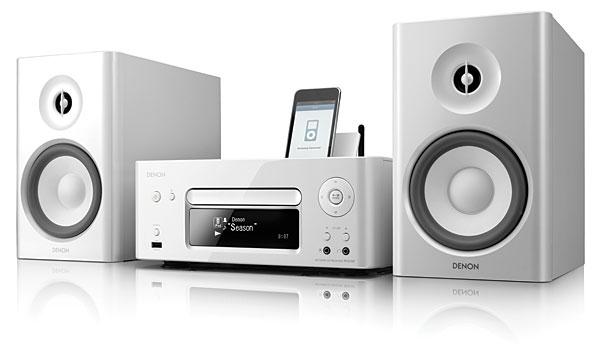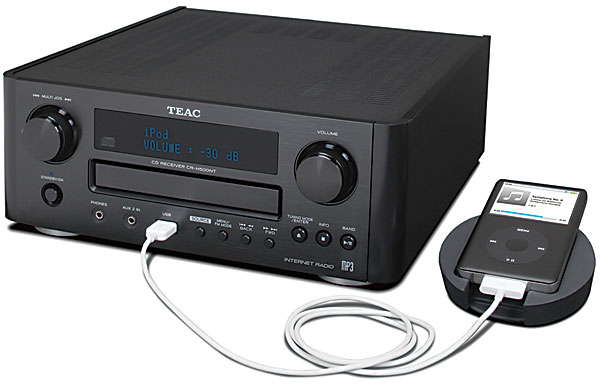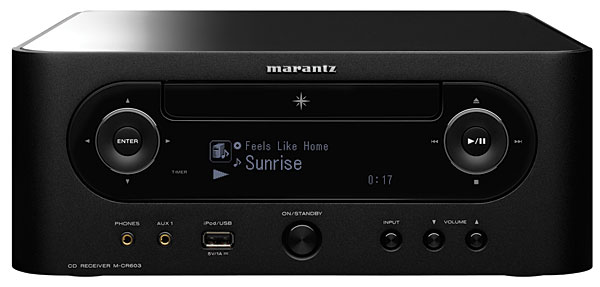| Columns Retired Columns & Blogs |
The Fifth Element #68

In large part because I was fascinated by the potential of Direct Acoustics' Silent Speaker II loudspeaker ($748/pair) in affordable systems (see my columns in the June 2011 and August 2011 issues), I rounded up three CD receivers that are network- and Internet Radio–ready and cost under $1000: one each from TEAC, Marantz, and Denon. These models are functionally and cosmetically more similar than different, and, it turned out, sounded more alike than not.
I was also curious to hear them as a follow-up to my quest of a couple of years back to use affordable but non-network CD receivers as the foundation of affordable systems in the $2500–$3750 range. My thinking was that mass-market brands could take advantage of greater economies of scale than boutique or smaller builders. And indeed, the maker of one of my favorite CD receivers from that series of columns, Carat, soon after closed its doors.
This new crop of CD receivers offers quite respectable sound at prices from $600 to $800, which qualifies them as genuine bargains. I was actually less interested in their MP3, USB, and network capabilities than I was in their basic performance as CD receivers, both from the notion that many people, especially classical fans, still put discs into trays and slots to hear most of their music, and from my conviction that MP3 files and Internet Radio, being compromised sound sources, are not going to show what a component is really capable of.
Another aspect not to be disregarded is that people who have music on their Apple computers can accomplish the same networky things these units do by getting an AirPort Express, which at $99 is also quite a bargain, and plugging its analog outputs into a conventional receiver. By the way, none of these CD receivers appears able to handle AIFF files via its USB inputs (I tested), so if you have an Apple computer and want to load tunes onto a memory stick, be sure to save your files as .wav files, and at no higher resolution than "Red Book" CD quality.
As I mentioned in my June 2011 write-up of the Silent Speaker II, as nice as these budget CD receivers were, they weren't as up to the task of coping with the demands of the Silent Speaker's bass-loading scheme as were the far more expensive Ayre AX-7e integrated amplifier and Ayre CX-7eMP CD player ($7000 for the pair). This was immediately apparent on runs of the sinewave sweeps from Ayre's Irrational, But Efficacious! System Enhancement Disc, Version 1.2, which as far as I'm concerned has earned the title "Break-In in a Can."
With the Ayre separates, the sinewave bass frequencies were audible from the Silent Speaker II much earlier than from any of the new CD receivers, and were stronger throughout, despite the Ayre integrated and the CD receivers all having power ratings within the range of 40–60Wpc. Rated wattages often don't make as much difference as do current capability and damping factor, which are usually related to power-supply robustness, which is usually related to a component's weight and price. All of these CD receivers have the shape of a bakery box, all have remote controls as standard features, and all are made in China.
Denon's RCD-N7 ($599.99) weighs 9.8 lbs and looks like an Eskimo Pie from which a child has carefully levered off all the chocolate coating with his top front teeth. It's cute as all get-out, and very "modern" looking, with its minimal front-panel controls in white plastic. It has both wired (Ethernet) and wireless network connectivity. Alone of these three CD receivers, it has an integral iPod dock in its top panel (the others connect via USB cable). Like its corporate sibling, the Marantz M-CR603, Denon's RCD-N7 offers Apple's AirPlay software, which allows you to access your iTunes library and control it via your iPod, iPhone, or iPad. The RCD-N7's amplifier is specified at 65Wpc into 4 ohms.
Marantz's M-CR603 ($699.99) looks more like a traditional stereo component, with a black case with rounded front corners and blue illumination. It has wired network connectivity, but not WiFi. Its front USB port can also accept a memory stick, or an iPod connection. I found it a bit curious that the Denon RCD-N7 is rated at 65Wpc into 4 ohms but the Marantz at 40Wpc into 8 ohms, and that each weighs 9.8 lbs. Perhaps, under their differing casework, they are essentially twins.

TEAC's Reference Series CR-H500NT is the most expensive of the three ($799.99), and features a Burr-Brown 24/192 DAC chip and, alone of these CD receivers, provides a phono input. What's more, it offers the ability to rip your LPs to a memory stick or to network storage—but only as MP3 files. It has both wired and wireless network connectivity, but doesn't offer an upgrade to Apple AirPlay. There is an optional matching iPod dock. The CR-H500NT is rated at 40Wpc into 6 ohms and weighs 12.4 lbs. Of the three CD receivers, only the CR-H500NT has a standard three-prong IEC power receptacle on its rear panel, which gives the user the opportunity of upgrading to an aftermarket AC cord.
I listened extensively to the TEAC and Marantz models with the Direct Acoustics Silent Speaker IIs, then to the Denon with the matching, white-gloss SC-N7 two-way bookshelf speakers ($199/pair), and then to all three with 1990s-vintage Rogers LS3/5a minimonitors. They all sounded surprisingly good through the semi-vintage LS3/5as, which are not a very easy load. So one of these receivers and a used pair of British monitor-ish speakers might make for a nifty and affordable second system.
With the Silent Speaker IIs being driven by TEAC's CR-H500NT, I listened to Dagmar Peckov†'s recording of Wagner's Wesendonck Lieder, with Jiri Belohl†vek and the Prague Philharmonic (CD, Supraphon SU 3417-2 231), and quickly forgot the comparative lack of bass control and finesse—I just got lost in the music. I was genuinely surprised that I was getting real goose bumps from a system that cost well under $2000 all in, including Nordost speaker cables and the upgrade power cord. I was similarly caught up in my favorite version of Debussy's La Mer: the epochal early-stereo recording (1956) by Charles Munch and the Boston Symphony (CD, RCA Papillon 6719-2-RG).

Almost all of my listening was to CDs rather than to thumb drives or network connections, because I believe that the most important equipment interface is between the power amplifier and loudspeakers it drives. Pandora is great—I listen to it a lot, mostly to learn about music I'll want to hunt down on used CDs—but to me, Internet radio is Internet radio. It is what it is, with limited bandwidth and compressed data.
As a sanity check, I did try all three CD receivers with a CD-quality .wav file stored on a USB thumb drive, and compared that to the sound of the CD spinning in the tray. The track was Greg Williamson and the Big Bad Groove Society's cover of Miles Davis' "Dig," from their Swing Your Big Head (CD, Pony Boy PB 50110 2). In all three CD receivers, the USB port and the CD sounded pretty much identical. At times it might have seemed that the USB was slightly more articulate, but this impression was neither strong nor consistent. Furthermore, if there were essential sound differences between the Denon and the Marantz, I didn't hear them. I tried the FM radio feature, and it sounded like local FM radio: ehh.
Between the TEAC and the Marantz, I concluded that, through the Silent Speaker IIs, the Marantz produced a slightly greater quantity of bass from my own pipe-organ recordings, but that the TEAC's bass was slightly better controlled. I also felt that the TEAC was slightly more refined with "So Do I," from Christy Moore's This Is the Day (CD, Columbia Sony Music 5-3225.2). I rechecked with the LS3/5as, and my impressions held.
Which to buy? Your choice should be dictated by which feature set best fits your needs. If you want to play LPs, the TEAC should be your choice, but if you want fingertip access to iTunes via your iPad and hear the playback through a small system, you'll have to decide between the Denon and the Marantz. While I slightly preferred the sound of the TEAC, that preference was slight. I preferred the TEAC's ergonomics because I use front-panel controls more often than remote controls, and the TEAC is the only one of the three with a volume knob instead of two pushbuttons. The TEAC also accepts an aftermarket power cord, but that makes sense to me only if you already have one lying around; otherwise, you'd be better off buying a more expensive CD receiver to start with.
At the end of the day, each of these cute models offers very good value for money, but is perhaps slightly too compromised in terms of sound to be the sole serious stereo of anyone not on a truly straitened budget. (And even that person might be better off carefully shopping for fully depreciated used equipment.)
- Log in or register to post comments




































